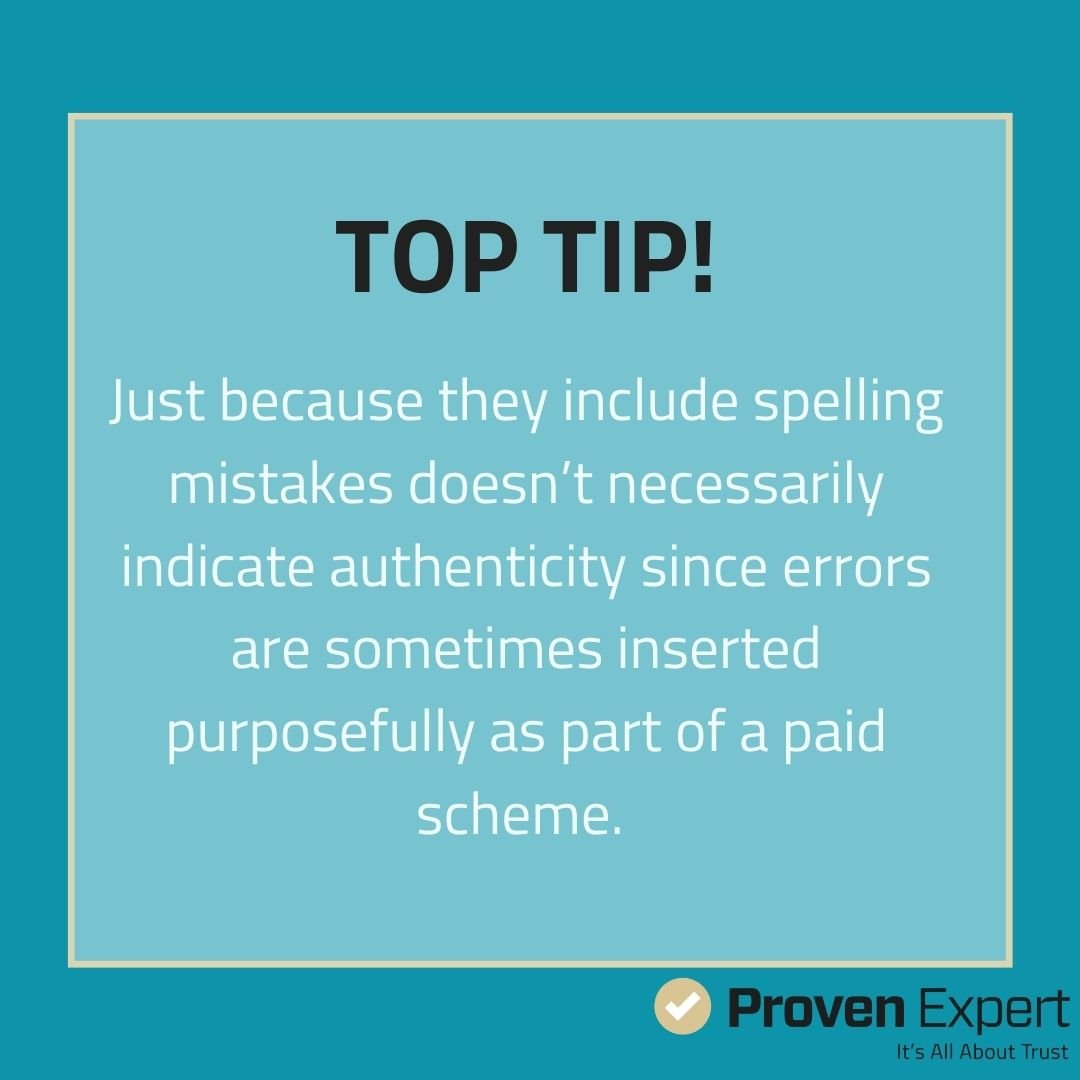Easily spot fake reviews - How can ProvenExpert protect you from them?
Last updated: September 1, 2022Tip 1: Look for exaggerated over the top praise
Does the review sound like an advertisement? If it’s way too over the top, then it’s likely a scam. If you're happy with your last haircut or glad to have finally found a compassionate dentist, it's common to give praise. However, if there’s a strange overbearing level of positivity, you should read additional reviews to get an accurate idea.
Look out for:
- Multiple superlatives contained within the review
- Every sentence describing the service or the company as phenomenal and fantastic.
- Eerily similar reviews that all highlight the same feature

TOP TIP: Just because they include spelling mistakes doesn’t necessarily indicate authenticity since errors are sometimes inserted purposefully as part of a paid scheme.
Tip 2: Find out the number of ratings for the product or service
Look at how many ratings a company or service provider has already received. Think whether the number is appropriate for the type of company. If a small auto garage or a suburban hair salon has 20,000 ratings, it could be a sign that they've had some help.
Tip 3: Investigate the reviewer
The name of the person giving the rating can also contain clues. First and last names don't always have to appear, but sometimes it pays off to look closer. There might be a pattern if multiple extremely positive ratings stem from handles such as “Sweetie1990” or “Steve7040“.
Tip 4: Identify any self-promotion from competing companies
Sometimes, users create ratings just to place a link on an external website or advertise a competing product. These are often ratings without any firm foundation. Of course, someone who has a similar effect to sell will not recommend another.
Note:If possible, read both positive and negative ratings and look for older feedback. It's always recommended to base your decision on the big picture.
What ProvenExpert is doing to combat fake reviews
Here at ProvenExpert our team have implemented various technical and manual processes to make submitting fake reviews as difficult as possible for the scammers. We’re fighting fake reviews with:
1. Rater verification for more security
- Double-opt-in with a valid email address is required to make a valid rating
- Verification via social networks (LinkedIn, Xing, Facebook, Google) is possible
- Email addresses must correspond to our criteria (no double ratings, no trash email addresses, etc.)
2. ProvenExpert users have complete control
- Profile owners can decide who can rate them
- Online surveys can be made publicly accessible or made reachable only using an access code invitation sent per email
- Profile owners have to approve sent reviews (However, if not all ratings have been approved, the public profile and the Expert Seal will no longer display the overall result, but only the number of approved ratings. This is done to ensure transparency for users.)
3. Control by our editors and the Community
- An internal verification system flags suspicious ratings received from surveys (comparison of email address with the one registered to the user account and the browser fingerprint) and routes them the quality assurance team.
- Reported ratings are checked (an arbitration process is started if necessary)
- ProvenExpert deletes ratings that don't correspond to evaluation criteria
- External rating sources are only allowed if the platforms accept exclusively genuine customer ratings.
No company can benefit from trying to convince new customers to buy its products using fake ratings. The quality won't measure up at the end, and the customer will return the product or complain about the service. Thanks to current consumer protection law, this is easy (the right to revocation and goods return, the right to services remedy, compensation entitlement, etc.)
Many companies don't realize that fake reviews for poor quality goods and services only result in higher costs in the long run. In addition, fake reviewing is illegal– you can read more on this topic in an earlier blog post.
We don't know whether CEOs of cheating companies realize the jeopardy they are placing themselves in by allowing fake reviewing to take place. If you’d like to hear some real-life funny stories of businesses catching out the perpetrator, check out this hilarious Buzzfeed article.
We hope that we can give you a better sense of rating appraisal. In the next article in our blog series, we will examine the legal aspects of fake ratings in an interview with a lawyer.
Summary
Follow these tips to help you form a better opinion on whether customer reviews are fake or not:
Tip 1: Look for exaggerated over the top praise
Tip 2: Check the overall number of ratings
Tip 3: Investigate the reviewer
Tip 4: Identify any self-promotion from competing companies
Want to take control over your reputation? Manage your reviews with ease on ProvenExpert now.
